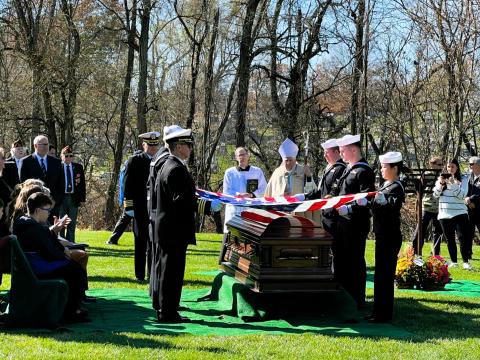Decades after he died, a Pearl Harbor sailor comes home

Listen to this Episode
Most of the people at Stanley Galaszewski’s burial ceremony never knew him.
He died more than 80 years ago.
Still, the crowd on the crisp November afternoon swelled with extended family, leather-jacketed Patriot Guard Riders, a group of quiet school children.
Together, they bowed their heads in prayer to honor the fallen World War II sailor.
He was one of thousands of Americans — sailors, soldiers, civilians — who lost their lives on Dec. 7, 1941 during the attack on Pearl Harbor.
After decades of being listed as missing, he’s finally back in the place he called home: Steubenville, Ohio.
The sailor’s service
Galaszewski was 28 years old when he enlisted in the Navy in 1940. He became a Seaman 2nd Class and was stationed on the USS California.
Just weeks before the bombing of Pearl Harbor, he wrote a letter to his sister.
Her granddaughter, Deb Conti, still has it.
“He writes how much they don't need to worry about him,” Conti said. “It seems like they were all close. They were two years apart, so I know he was important to my grandmother and they were worried about him.”
Six weeks later, the Japanese military attacked the U.S. naval base. The USS California was slammed with torpedoes and bombs. It caught fire and slowly sank.

Like so many people in Pearl Harbor that day, Galaszewski was listed as missing. His family never knew for sure what happened to him.
Until this September.
That’s when Deb Conti got a phone call from the Navy.
“I thought it was a hoax,” Conti said. “I really didn't understand.”
Decades after he died, the Navy had identified Galaszewski’s remains.
The process of identifying long-fallen servicemen
Captain Jeff Draude, the director of Navy Casualty, said identifying long-dead servicemen like this isn’t easy.
Hundreds of people were on board some of the ships that sank during the attack on Pearl Harbor. Their remains were recovered in the months that followed and interred at the Halawa and Nu’uanu cemeteries in Hawaii.
But only relatively recently — with the advancement of DNA technology — has the Navy been able to identify some of those remains.
Now, Draude’s team is going through them one by one.
“Since they can get the DNA from these remains and we know who was on the ship, we can reach out to their living relatives,” Draude explained. “Their DNA reference samples go to the lab and then they're all cross-referenced, so that’s how they’re able to get these matches nowadays from so many years ago.”
“I always remembered my grandma saying she wished she could have brought him home."
Deb Conti
The Navy has been doing this work since 2015, but there’s still more to go. Draude says they won’t be finished until each missing serviceman is identified.
“These are sailors and marines that paid the ultimate sacrifice for service to their country,” he said. “There's no statute of limitations on that.”
Each time an ID is made, a member of Draude’s team personally reaches out to their family.
“We're not talking about a son or daughter or a spouse anymore because it's been so many years,” Draude said. “But we'll have anything from, ‘my family was always hoping that they weren't really on the ship that day’ [to] relief to finally have that closure.”
Sitting beside her cousins, her children and her grandson, Conti finally felt that closure for her great-uncle, Stanley Galaszewski. Like many families, she chose to have his body moved from its resting place in Hawaii to a location closer to home.
“I always remembered my grandma saying she wished she could have brought him home,” Conti said.
With Draude’s help, she has finally fulfilled that wish.
Stanley Galaszewski is now buried behind his parents at the Mount Calvary Cemetery in Steubenville.
9(MDYwODMwNTczMDE2ODk5NTExNDAyNzM5Ng000))
- Home
- Schedules
- TV
- TV
- Local TV Programs
- Business | Life 360 with Kristi K.
- Toledo Stories
- To The Point with Doni Miller
- Listening with Keith Burris
- Ideas & Insights
- WGTE Presents
- BL360: Northwest Ohio Innovation Consortium
- Magic of the Old West End
- Freedom Means Never Surrender
- I&I: The Random Factor
- FF: National Cherry Festival
- TTP: Moms Demand Action For Gun Sense in America
- Watch Live
- Radio
- Education
- Community
- Support
- About
- Donate
- Watch Live


